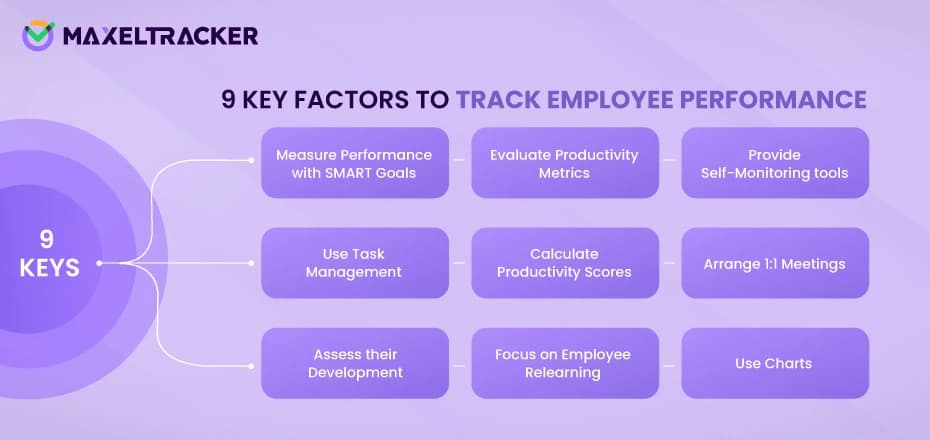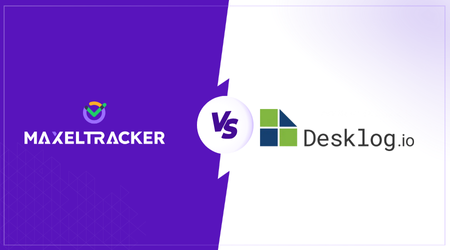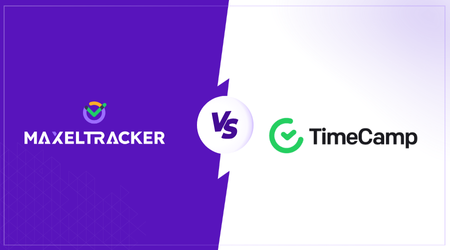

Efficient organizations are fundamentally dependent on their employees. Regardless of size or industry, the performance of your workforce is essential for achieving strategic objectives.
To ensure your employees can handle difficulties at work, it's crucial to monitor their performance. A well-implemented performance-tracking system benefits both employees and the organization by addressing factors such as job satisfaction, role alignment, morale, and motivation.
Doing so allows you to identify challenges early and provide support that can enhance your skills and efficiency.
If you're new to performance-tracking strategies, this guide will help you pinpoint areas for improvement and align your workforce with company goals.
SMART goals—Specific, Measurable, Actionable, Relevant, and Time-bound—are essential for aligning employee performance with your company’s production and revenue targets. Evaluating performance against unrealistic benchmarks is not effective.
Begin by setting clear and precise goals to eliminate ambiguity. When employees understand exactly what is expected, they are more motivated to meet those expectations. Utilize measurable key performance indicators to track progress accurately.
Ensure that goals set by supervisors and managers are realistic and attainable. These goals should align with both the employees' roles and the broader objectives of the organization. Additionally, set clear deadlines to create a sense of urgency and maintain employee focus.
In blue-collar roles, the primary measure of performance is the output. To accurately assess these employees, you should evaluate both the quality and quantity of the work they produce. This approach ensures a comprehensive understanding of their productivity and effectiveness. Additionally, performance should be assessed based on the time taken to produce each result or product. This approach provides a precise measure of efficiency and is especially effective in industries such as manufacturing and construction.
High-performing workers consistently meet their goals, so this should be a key part of the evaluation. Performance tracking should include both result and time metrics. This approach offers a clear view of the employee's error or defect rate, with fewer errors generally indicating better performance.
Ambiguous feedback from managers or supervisors can leave employees frustrated and unclear about how to improve. Instead of offering vague critiques like, “Christie, you took too long to assemble the headlight,” provide actionable self-monitoring tools that help employees track their own performance.
Time tracking tools are essential for helping employees allocate their time effectively across various tasks. By using these tools, employees can monitor extra time they spend on each task, getting clear insights into their efficiency.
Additionally, encourage the use of checklists and planners. These tools help employees stay organized, track employees locations, tasks and deadlines, and manage their workload more effectively. Providing these resources not only helps in performance tracking but also fosters a proactive approach to personal and professional development.
Effective task management is key to organizing and optimizing employees' daily activities. Utilizing task scheduling tools can significantly enhance employee performance and productivity. This comprehensive idle time tracking software provides robust team management capabilities. As a cloud-based, hardware-free solution, it streamlines the process of tracking performance, especially for blue-collar workers.
MaxelTracker is designed to track work hours for employees working remotely, full-time, part-time or contractors.
To drive continuous improvement, it's essential to develop an employee productivity score. This score helps assess whether an employee’s performance is improving or declining. Recognizing and rewarding productive employees is crucial, as failing to acknowledge their efficiency can lead to losing them to competitors.
Based on key performance metrics like productivity, reliability, and efficiency you can create a productivity score. With this, you can easily compare the score of the employee with its previous data and find the areas of improvement.
Regularly tracking the productivity score allows you to monitor employee performance consistently and implement corrective measures as needed. This proactive approach ensures that any performance issues are addressed promptly, supporting ongoing development and enhancing overall productivity.
Face-to-face interactions are essential for effective communication and performance management. Many companies are bringing employees back to the office to enhance these essential conversations.
1:1 meetings create a constructive environment where managers and employees can exchange feedback openly. These meetings allow managers to address concerns, recognize achievements, and provide guidance. Employees, in turn, can share their thoughts, seek clarification, and ask questions.
These meetings also offer a valuable opportunity to align individual goals with organizational objectives. Managers can ensure that employees focus on tasks that drive the company's success and offer tailored support to address any misalignment or specific challenges.
Regular 1:1 meetings help track employee performance continuously and strengthen the relationship between managers and their teams, fostering a more collaborative and productive work environment.
Continuous evaluation of employee progress is key to effective performance tracking.
But how do you evaluate their development?
One key indicator of growth is skill development. When blue-collar workers enhance their skills, they become more proficient in their roles, which leads to improved performance.
Recognizing employees' potential for growth allows you to implement initiatives that offer opportunities for internal promotions, fostering a committed and loyal workforce.
Ensure your organization provides the necessary tools and a supportive environment to enable employees to actively work on their development and performance improvement.
In today’s fast-paced industries, maintaining relevance and profitability demands a strong commitment to continuous learning. Promoting ongoing education is vital for tracking and improving employee performance.
Employees should be motivated to develop new skills and adapt to new technologies. Companies can support this by offering access to training programs and resources that enable relearning and skill enhancement.
Additionally, evaluate the impact of these relearning initiatives on performance. This will offer a clear perspective on the improvements resulting from these efforts and help gauge the effectiveness of your investment in employee development.
Save 70% of Your Operational Cost with Employee Monitoring Solutions Today!
Try MaxelTracker Free for 14 Days
Managing multiple teams or a large workforce can generate vast amounts of performance data, making it challenging to track and analyze. To simplify this process, use performance tools that convert extensive data into easily understandable charts.
Charts help visualize performance metrics, making it easier to grasp trends and insights at a glance. By leveraging these visuals, you can efficiently monitor and interpret employee performance across large teams.
In today’s workforce management landscape, tracking employee performance is essential for various reasons. Regardless of an organization’s size or industry, it significantly contributes to its growth and success. Monitoring employee activities in real time is crucial for several key reasons:
Tracking employee performance is essential for fostering a culture of accountability and transparency. When employees know that their activities are being monitored in real time, they are more inclined to take their responsibilities seriously. This awareness encourages a sense of ownership and dedication to their roles, which enhances overall commitment and performance.
Monitoring employee performance offers critical insights into how resources are managed. It allows managers to pinpoint and resolve any resource allocation issues that are creating hindrances in productivity. Furthermore, performance tracking identifies top performers and those requiring additional support, facilitating a more strategic and effective distribution of resources.
Without proper performance tracking, favoritism and biases can influence management decisions. Tracking employee productivity ensures that promotions, salary adjustments, and recognitions are based on objective merit rather than personal biases. This approach fosters a more equitable work environment and enhances employee morale.
For organizations seeking to make data-driven decisions in workforce management, tracking employee performance is essential. It provides a clear and impartial basis for evaluating and rewarding employees, leading to a more equitable and motivated workforce.
Effective workforce management in today's complex environment necessitates sophisticated methods for tracking employee performance. Alongside implementing strategies such as setting clear goals, monitoring performance, and promoting continuous learning, it’s important to use a staff attendance monitoring tool like MaxelTracker for productivity monitoring, task management, and oversight.
By combining the right strategies with advanced solutions, you can ensure that your employees continually develop and adapt to meet the evolving industry demands.
👉 Sign up now at MaxelTracker.com and start transforming your team’s productivity today! 🚀
👉 Explore our pricing plans and features to find the perfect solution for your team’s productivity needs! 🚀
Related Blogs

Insightful Alternatives & Competitors
Looking for an alternative to Insightful that offers a more tailored approach to workforce productivity and employee monitoring? We’ve got you covered.

Desklog Alternatives & Competitors
MaxelTracker is an all-in-one workforce platform that tracks time, monitors activity, and delivers deep productivity insights, giving you more than just project and task logging.

TimeCamp Alternatives and Competitors
Tracking employee productivity is crucial for businesses aiming to boost efficiency, meet deadlines, and manage workloads effectively. The right tool can provide valuable insights into work patterns, improve time tracking, and simplify reporting.